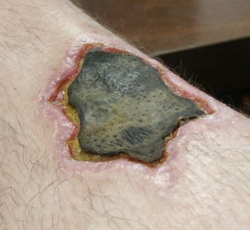Loxoscelism

Editor-In-Chief: Prab R Tumpati, MD
Obesity, Sleep & Internal medicine
Founder, WikiMD Wellnesspedia &
W8MD medical weight loss NYC and sleep center NYC
| Loxoscelism | |
|---|---|

| |
| Synonyms | N/A |
| Pronounce | N/A |
| Specialty | N/A |
| Symptoms | Necrosis, pain, fever, chills, rash |
| Complications | Renal failure, sepsis, hemolysis |
| Onset | 2 to 8 hours after bite |
| Duration | Weeks to months |
| Types | N/A |
| Causes | Brown recluse spider bite |
| Risks | Living in areas where Loxosceles spiders are common |
| Diagnosis | Clinical evaluation, history |
| Differential diagnosis | Cellulitis, pyoderma gangrenosum, erythema migrans |
| Prevention | Avoidance of Loxosceles spiders, use of insect repellent |
| Treatment | Wound care, pain management, antibiotics if infected |
| Medication | Analgesics, antihistamines, corticosteroids |
| Prognosis | Generally good with treatment, but can be severe |
| Frequency | Rare |
| Deaths | N/A |

Loxoscelism is a condition resulting from the bite of a member of the Loxosceles genus of spiders (also known as recluse spiders or brown spiders). The condition can be divided into two forms: cutaneous loxoscelism and systemic loxoscelism.
Symptoms[edit]
The symptoms of loxoscelism can vary depending on the form of the condition.
Cutaneous Loxoscelism[edit]
Cutaneous loxoscelism is the most common form of the condition. Symptoms typically begin within 2 to 8 hours of the spider bite and can include:
- A small white blister at the site of the bite
- Redness, swelling, and tenderness around the bite
- Development of a necrotic skin lesion
Systemic Loxoscelism[edit]
Systemic loxoscelism is less common but more severe. Symptoms can include:
- Fever and chills
- Rash
- Nausea and vomiting
- Joint pain
- Hemolysis (breakdown of red blood cells)
Diagnosis[edit]
Diagnosis of loxoscelism is typically based on the clinical presentation and a history of a spider bite. However, it can be difficult to confirm as other conditions can cause similar symptoms and spider bites are often not witnessed.
Treatment[edit]
Treatment for loxoscelism is primarily supportive. This can include:
- Pain relief
- Wound care for any skin lesions
- Treatment of any secondary infections
In severe cases of systemic loxoscelism, hospitalization may be required.
Prevention[edit]
Prevention of loxoscelism involves avoiding contact with Loxosceles spiders. This can include:
- Wearing gloves when handling firewood or other items where spiders may be hiding
- Shaking out shoes and clothing before wearing
- Regularly cleaning and decluttering to reduce potential hiding spots for spiders
See Also[edit]
Ad. Transform your life with W8MD's Budget GLP-1 injections from $75


W8MD offers a medical weight loss program to lose weight in Philadelphia. Our physician-supervised medical weight loss provides:
- Weight loss injections in NYC (generic and brand names):
- Zepbound / Mounjaro, Wegovy / Ozempic, Saxenda
- Most insurances accepted or discounted self-pay rates. We will obtain insurance prior authorizations if needed.
- Generic GLP1 weight loss injections from $75 for the starting dose.
- Also offer prescription weight loss medications including Phentermine, Qsymia, Diethylpropion, Contrave etc.
NYC weight loss doctor appointmentsNYC weight loss doctor appointments
Start your NYC weight loss journey today at our NYC medical weight loss and Philadelphia medical weight loss clinics.
- Call 718-946-5500 to lose weight in NYC or for medical weight loss in Philadelphia 215-676-2334.
- Tags:NYC medical weight loss, Philadelphia lose weight Zepbound NYC, Budget GLP1 weight loss injections, Wegovy Philadelphia, Wegovy NYC, Philadelphia medical weight loss, Brookly weight loss and Wegovy NYC
|
WikiMD's Wellness Encyclopedia |
| Let Food Be Thy Medicine Medicine Thy Food - Hippocrates |
Medical Disclaimer: WikiMD is not a substitute for professional medical advice. The information on WikiMD is provided as an information resource only, may be incorrect, outdated or misleading, and is not to be used or relied on for any diagnostic or treatment purposes. Please consult your health care provider before making any healthcare decisions or for guidance about a specific medical condition. WikiMD expressly disclaims responsibility, and shall have no liability, for any damages, loss, injury, or liability whatsoever suffered as a result of your reliance on the information contained in this site. By visiting this site you agree to the foregoing terms and conditions, which may from time to time be changed or supplemented by WikiMD. If you do not agree to the foregoing terms and conditions, you should not enter or use this site. See full disclaimer.
Credits:Most images are courtesy of Wikimedia commons, and templates, categories Wikipedia, licensed under CC BY SA or similar.
Translate this page: - East Asian
中文,
日本,
한국어,
South Asian
हिन्दी,
தமிழ்,
తెలుగు,
Urdu,
ಕನ್ನಡ,
Southeast Asian
Indonesian,
Vietnamese,
Thai,
မြန်မာဘာသာ,
বাংলা
European
español,
Deutsch,
français,
Greek,
português do Brasil,
polski,
română,
русский,
Nederlands,
norsk,
svenska,
suomi,
Italian
Middle Eastern & African
عربى,
Turkish,
Persian,
Hebrew,
Afrikaans,
isiZulu,
Kiswahili,
Other
Bulgarian,
Hungarian,
Czech,
Swedish,
മലയാളം,
मराठी,
ਪੰਜਾਬੀ,
ગુજરાતી,
Portuguese,
Ukrainian


